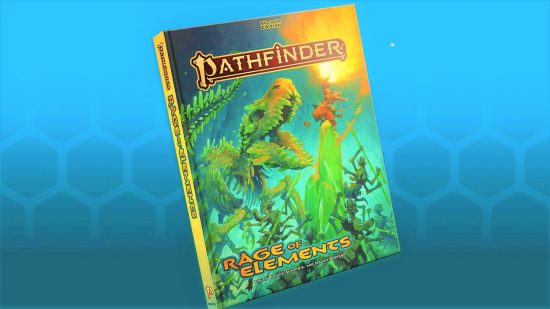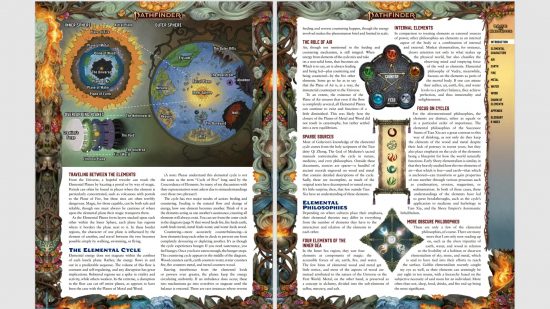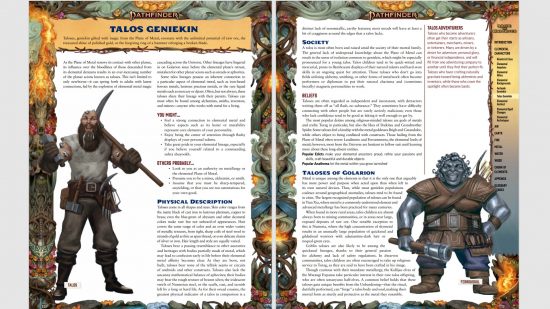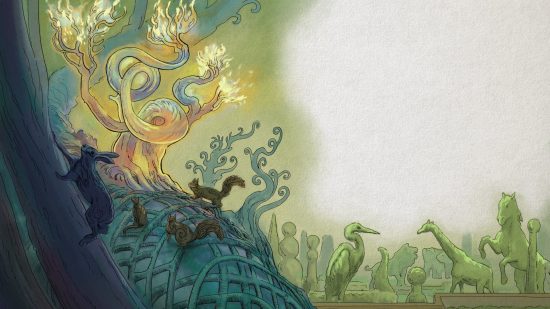Our Verdict
Rage of Elements does an excellent job reestablishing the elemental planes with thoughtful worldbuilding and creative player options. Not everything will blow you away, but there's more than enough for a budding elementalist to play with.
Pathfinder: Rage of Elements has to pack a lot into 200-odd pages. This is a book that rewrites the Universe as players know it, adding entirely new planes and an enormous player class to the TTRPG’s world. These are big changes with far-stretching fallout – and, to add fuel to the fire, this is the first Pathfinder book that’s shifted to be compatible with the upcoming 2e remaster.
Paizo had a tall order on their hands. Fortunately, they’ve pulled it off. Rage of Elements is stuffed to the brim with careful worldbuilding, creative designs, and exciting character options.
Below I’ve shared details on the full Rage of Elements sourcebook (thank you to Paizo for sharing a review copy). I’ve also detailed my initial first impressions – I’ve not had a chance to thoroughly test the book’s contents yet, so bear in mind that these thoughts are based on a first readthrough.
What is Rage of Elements?
Set to release in early August, Rage of Elements is a Pathfinder 2e sourcebook entirely dedicated to the elements. This means we get an in-depth tour of the elemental planes – including the Plane of Wood and the Plane of Metal, which have mysteriously reappeared.
This also means a wave of new player options. The Kineticist – apparently the longest class in second edition so far – returns to join the roster of 2e Pathfinder classes. A handful of new Pathfinder races and archetype options are also sprinkled in, plus a huge range of spells to play with.
Introduction to the elements
For a long time, elementalists believed there were only four elemental planes – Earth, Wind, Fire, and Air. There are actually six, with Metal and Wood included.
The arrival of mortals in the universe changed the behavior of the Elemental Lords in charge of each plane. Some grew malevolent and eventually imprisoned their more benevolent counterparts to gain full control of their planes. The planes became imbalanced, weakening Metal and Wood until they seemed to fade away completely.
At the (in-universe) time of writing, the good Elemental Lords of each plane have been recovered, and Metal and Wood have returned. The sourcebook begins by recounting the history, philosophy, topography, and general function of the elemental planes.
It’s a super interesting read for any lore-lovers. However, for those more focused on rules and crunch, it’s also kept fairly brief. The majority of the book offers new, tangible options for players.
Kineticist 2e class
Kineticists aren’t your ordinary spellcasters. They’ve become a conduit that allows them to harness the power of an element (or, in some cases, several). Rather than spells, Kineticist use impulses to perform magic.
With 18 pages of general Kineticist feats and elemental-specific impulse feats to choose from, this class offers a huge amount of customizability. And, as far as first impressions go, I’m a huge fan of the Kineticist 2e class. It’s a fairly complex class, but that complexity comes with plenty of versatility.
The impulses are also packed with flavor. You’ll have all the standard impulses you’d expect (air lets you move swiftly, for example). However, some impulses are insanely creative. Here are some of my personal favorites:
- Sanguivolent Roots – a Wood impulse that creates blood-sucking vines that drain the vitality of your enemies and give it back to your party as HP.
- Retch Rust – a Metal impulse where you puke flakes of rusted metal that slashes your enemy’s skin to ribbons.
- Ambush Bladderwort – Mix Wood and Water to create a man-eating plant that swallows an enemy, drowns them, then shrinks down so you can eat it and gain HP.
- Lightning Rod – A mix of Metal and Air where you stab a foe with a metal rod, then call lightning to it and electrocute them.
The Kineticist has a lot of rules to wrap your head around, and I wonder how many of the impulses will end up too situational. But the creativity of the class’ design has me really excited to experiment.
Other character options
Existing Pathfinder classes also get some new options in Rage of Elements. A range of elemental companions are listed, along with new backgrounds to tie your characters to the elemental planes. Barbarians also get a new Elemental Barbarian Instinct, which allows them to specialize in certain types of elemental damage and use the elements to hide from ranged attacks.
The Elementalist archetype features too, getting a brand-new rewrite to account for the updated elemental planes. Paizo makes it clear the old Elementalist is still playable, but this is a more updated equivalent.
As for ancestries, Rage of Elements also introduces two new Geniekin from the Planes of Metal and Wood. Ardande Geniekin can communicate with the trees, use them to find food, and make a battlefield more difficult to traverse. Meanwhile, Talos Geniekin have metal in their blood, which makes their unarmed hits tough, toxic, and electric.
The new ancestry options are markedly different from each other and both offer interesting potential. However, the Kineticist shone so brightly that other player options in Rage of Elements felt a little dim in comparison.
The elemental planes
The rest of the book is dedicated to exploring each of the six elemental planes, as well as ‘the churn’, which is pockets of space where elements mix. All of these get new spells, monsters, items, and deities along with a splash of lore. These are well-crafted worlds with unique identities, presented with excellent writing.
In terms of gameplay options, the new spells were the major draw for me. Each element seems fairly well-rounded to give a lot of flexibility with builds. Some have more specialisms – water leans more towards healing than the other elements, and earth feels very defensive – but most offer spell options that cover a range of combat styles. Just because you’re casting fire spells, doesn’t mean you’re limited to throwing fireballs.
I was slightly less impressed by the range of monsters. To be fully fleshed out, each plane needed its own version of genies, elementals, and so on. There are some really neat designs (shout out to the Lithic Loci), but the worldbuilding requires some repetition – which meant I wasn’t bowled over at every new stat block.
Perhaps it’d be too much to expect Paizo to reinvent the wheel at every turn in Rage of Elements – a lot of the book was already dedicated to an entirely new class for 2e. Overall, if you’re a lover of all things elemental, or you’re looking to dabble in a new, sort-of-spellcasting class, there’s a lot to love about the new Pathfinder book.





